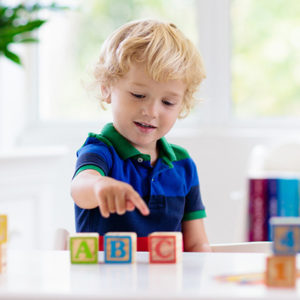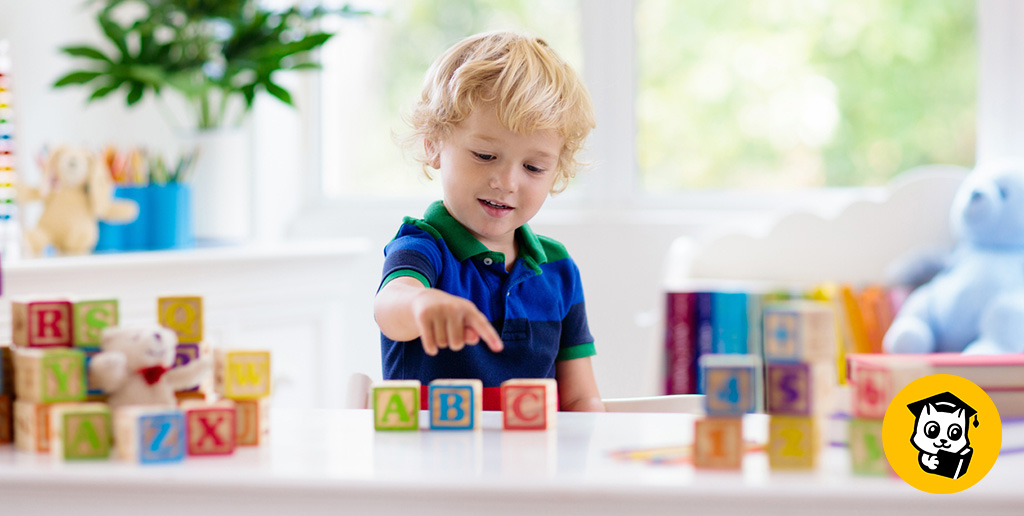Learning the English alphabet is an important step for acquiring the language. By learning the order and all of the names of the letters, your child gains the ability to identify the written word and the tools to begin phonetic reading.
Use the Alphabet Song.
The alphabet song is a tradition for good reason. It uses Mozart’s classic, wonderfully memorable melody of “Twinkle, Twinkle Little Star.”
Using this song and even other melodies to help memorize the order of the letters will prove to be very helpful as you practice.
Find a poster with the letters of the alphabet on it. The letters should be big enough for your child to touch with their whole hand while they sing. If you can’t find a poster like that at your local bookstore, then get a whiteboard or a poster board big enough for you to write out all 26 letters in upper and lower case.
At the start of each lesson, sing the whole song and touch the letters together with your child. This is a great opportunity to be silly. Sing the song once very, very slooowwly. Sing the song once very, very quickly. Then sing the song at the normal tempo.
Focus on a new group of letters for a separate lesson each night. Use the melody of the song to find the groups of letters, like this:
(Group 1) ABCD (Group 2) EFG/ (Group 3) HIJK/ (Group 4) LMNOP/ QRS/ TUV/ WXY and Z
Sing the letters in a high voice! Sing the letters in a low voice!
Eventually, ask your child to point to letters they have learned as you say them out of alphabetical order. “Z! A! G! Q!” Then, let your child call out letters and it’s your job to point to the letters that they call.
Don’t forget to make mistakes and let your child correct you!
Move on to a new group of letters each night. You will have many, many chances to review old lessons later. Give your child something new in every lesson, every night. Nothing kills learning like boredom.
Teach the individual letters.
Once your child knows the names of the letters from the alphabetical order, you can focus on the letters individually.
Get a set of alphabet cards, or better yet, get a couple of different sets. These cards will have different vocabulary words that start with each letter’s particular sound.
As you go through the different letters, find other words from each letter that your children may already know or that they will find useful and interesting. Like this:
A is for apple, and…. alligator, and ….ant, …and angry!
Alligator is angry! There’s an ant on her apple!
Teach other vocabulary while learning the alphabet.
Spend twenty minutes on the alphabet song and then move on to one of these other lessons: color words (red, orange, yellow, green, blue, purple, brown, white and black,) simple adjectives (happy, sad, angry, hungry, scared, beautiful and ugly,) and the verb “like.” All of these can be taught in short lessons on the same nights that your child learns the alphabet song. These lessons will come in handy later, after the alphabet song is finished and your child is ready to move on to phonics. I’ll explain why in Part 2 of this article.
Use different resources.
Teachers love coloring books and so do students. Get colorable worksheets from the Learning Resources at studycat.com. Let your child color pictures and take a break from language practice.
In addition to coloring books and whiteboards, you can use app games to help your child learn English letters. Studycat makes a really fun alphabet app called ABC Galaxy! There are many compelling reasons to use an app that has been specially created to make learning fun for kids. The best reason of all is this:
Your child should learn the names of the letters and the sounds they make from a native speaker with a standard American or British accent.
Children begin to make sounds when they are less than a year old. They learn sounds by mimicking the voices they hear around them. A child who is only exposed to their native language, will only learn to make those sounds, and those are different from English sounds. It’s very important, therefore, to expose your child to the accent of a native English speaker as early as possible. Apps are a great way to do that.
Finally…before you teach anyone, make up your mind to have fun teaching.
Play, not for your child, but for yourself. Be silly and play in a way that makes you, the teacher, happy. This is the secret that all the best teachers know: A happy, smiling teacher makes a happy, smiling student. A happy child will learn with you for as many hours as you have to share with that child.
And don’t forget about us. We at Studycat are teachers and parents just like you.
Follow the Studycat community on Facebook for more expert language learning advice »



